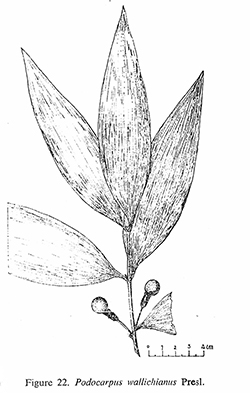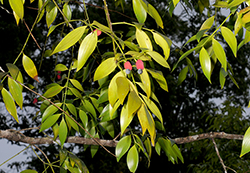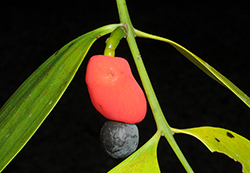e-Flora of Thailand
Volume 2 > Part 3 > Year 1975 > Page 203 > Podocarpaceae > Podocarpus
6. Podocarpus wallichianus C.Preslwfo-0000486916
Bot. Bemerk.: 110. 1841: Pilger in Pflanzenr. Taxaceae 18: 59. 1903; Dallim. & Jacks., Handb. Conif.: 85. 1923; Hickel in Fl. Gén. I.-C. 5: 1068. 1931: Suvatabandhu, J. natn. Res. Coun. Thailand 2: 62. 1961.— Decussocarpus wallichianus (Presl) de Laub., J. Arnold Arbor. 50: 349. 1969. Fig. 22.
Accepted Name : Nageia wallichiana (C.Presl) Kuntze
Revis. Gen. Pl. 2: 800. 1891.
Description : Tree, 10–20 m high, 80–150 cm in girth. Leaves coriaceous, opposite or subopposite, ovate to lanceolate-ovate, 10–18 by 3–5 cm; apex caudate to cuspidate; base acute, obtuse, rounded, or narrowly cuneate into a short petiole. Strobili 3–7 in a fascicle on a short axillary peduncle. Flowers solitary on a terete receptacle. Seeds globose, green or bluish-purple, about 1.5 cm diam. on a thick receptacle or nearly the same size of peduncle, all together 2–4 by 0.2–0.8 cm.
Thailand : NORTHERN: Nan; EASTERN: Nakhon-Ratchasima; SOUTH-EASTERN: Chanthaburi, Trat; PENINSULAR: Ranong, Nakhon Si Thammarat, Satun.
Distribution : India (type), Burma, Vietnam, Laos, Cambodia, Malaysia.
Ecology : In evergreen forests, from sea level up to 2,000 m alt.
Vernacular : Phaya mai (พญาไม้)(Southeastern); khun mai (ขุนไม้)(Peninsular).



